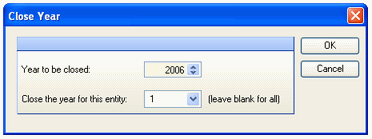
Important: Once you close a year, you will not be able to edit or add entries to that year.
Use the Close Year utility to close a fiscal year. You do not need to close a year at the end of the year in order to process the next year. You can have multiple years open at the same time.
When the year ends, and any AP and GJ grace period has expired, you should execute the Close Period utility so you can continue to process AP Invoice and General Journal entries. Compeat will check to determine if the period you are closing is the last period of the year. If it is the last period according to the Periods file, Compeat sets the current period to 1 and increments the current year by 1. For example, if you are in the last period of 2010 and you run the close period utility, the Current Period will be set to 1, and the Current Year will be set to 2011. All data is left intact.
Note: If you have set up any accounts that use the Statement Category of Dividends in your Chart of Accounts, when you close the year, these account balances will be subtracted from the sum of Retained Earnings and Current Year Net Income or Loss to arrive at the Retained Earnings for the new year.
When you are ready to close the year, select the Close Year utility, choose the year, and enter an entity # or leave blank to close all entities.
Note: Before closing the year, Compeat will check that either a Retained Earnings or Statistical Offset account (defined under Setup > Other Definitions > Other tab) exists in the Chart of Accounts.

Closing a year does the following:
Moves the general ledger detail from the closed year to a historical GL file. If you are closing the prior calendar year in June, it will not move any data from the current year; only the closed year data is moved. All of the data can still be reported on. It is moved to a historical file to keep the current general ledger detail file from growing excessively large; because there is less data to process, GL reporting is faster.
Adds the calculated profit for the year into the Retained Earnings account.
Sets the balance of each Profit and Loss account to zero.
Brings forward the balance of each balance sheet account.
Note: A batch code is assigned to the Close Year journal entry. The batch code uses the format CY - entity # - year #. For example, if closing the year 2009 for restaurant 100, the batch code might be CY-100-2009.